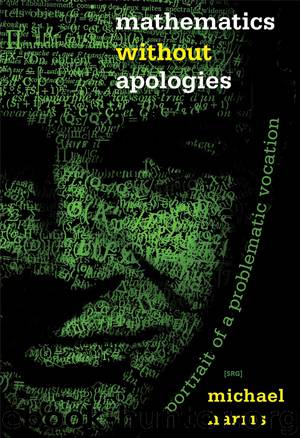Mathematics without Apologies by Harris Michael

Author:Harris, Michael [Harris, Michael]
Language: eng
Format: epub
Publisher: Princeton University Press
Published: 2015-03-25T14:00:00+00:00
Figure 8.1. A reconstruction of one of the less elaborate slides from Modern Algebra and the Object/Operation duality in music, a presentation by Moreno Andreatta, Music Representations Team, IRCAM/CNRS.
The Brahms Sextet … is one of those odd compositions which at times slipped from the pen of Brahms, apparently in order to prove how excellent a mathematician he might have become, but how prosaic, how hopeless, how unfeeling, how unemotional, how arid a musician he really was. You feel an undercurrent of surds, of quadratic equations, of hyperbolic curves, of the dynamics of a particle. But it must not be forgotten that music is not only a science; it is also an art. The Sextet was played with precision, and that is the only way in which you can work out a problem in musical trigonometry.60
Jazz age Paris saw arithmetic participate in the torture of the naughty child in Ravel’s L’enfant et les sortilèges, with libretto by Colette:
LE PETIT VIEILLARD :
Deux robinets coulent dans un réservoir; / Deux trains omnibus quittent une gare,
A vingt minutes d’intervalle, / Valle, valle, valle!
…
L’ENFANT :
Mon Dieu c’est l’arithmétique!
LE PETIT VIEILLARD :
Tique, tique, tique! / Quatre et quatre dix huit,
Onze et six vingt cinq, /Sept fois neuf trente trois.*
In 1930 music theorist Heinrich Schenker could just as well have written “mathematical” as “mechanical”—“the mechanical spreads throughout the entirety of average men like a poison gas”—when he contrasted Rameau’s “paralysis” with the living tradition represented by German musicians. “How,” he asked, “did the paralysis of the theoretical tendencies … manifest itself?” His answer was that “something mechanical … lay in the basic idea of Rameau from the start.”61
Well into the twenty-first century, mathematics is still widely seen as music’s diametrical opposite: “The pieces [Schoenberg] composed at this time were mystical, richly symbolic and emotionally charged, hardly pure mathematics,” wrote one British critic, while another adds that “once you’re inside music, all thoughts about mathematics become irrelevant.” Even Pierre Boulez, the founder of IRCAM, who elsewhere wrote that “music is a science as much as an art,” complained at one point that “what is called the ‘mathematical’ … mania … gives the illusion of [music as] an exact, irrefutable science” and referred to “number-fanatics” who seek a “form of rational reassurance.”62
Don’t you think there’s something pathetic about how certain mathematicians keep insisting that they are artists—we’ll see more of this in chapter 10—when the artists want only to keep their distance? It’s probably no accident that mathematics and classical music were not perceived as antithetical only during those periods when the notion of a “love formula” was not seen as oxymoronic. Rameau and Clairaut were contemporaries; Xenakis, Boulez, and IRCAM belong to the same world as Lacan and the structuralists, the world of an “objectivist” aesthetic of music in which “musical style … is eventually conceived in terms of statistics and music tends to lose its human significance.”63
Download
This site does not store any files on its server. We only index and link to content provided by other sites. Please contact the content providers to delete copyright contents if any and email us, we'll remove relevant links or contents immediately.
| Applied | Geometry & Topology |
| History | Infinity |
| Mathematical Analysis | Matrices |
| Number Systems | Popular & Elementary |
| Pure Mathematics | Reference |
| Research | Study & Teaching |
| Transformations | Trigonometry |
Modelling of Convective Heat and Mass Transfer in Rotating Flows by Igor V. Shevchuk(6353)
Weapons of Math Destruction by Cathy O'Neil(6084)
Factfulness: Ten Reasons We're Wrong About the World – and Why Things Are Better Than You Think by Hans Rosling(4625)
Descartes' Error by Antonio Damasio(3188)
A Mind For Numbers: How to Excel at Math and Science (Even If You Flunked Algebra) by Barbara Oakley(3187)
Factfulness_Ten Reasons We're Wrong About the World_and Why Things Are Better Than You Think by Hans Rosling(3162)
TCP IP by Todd Lammle(3099)
Applied Predictive Modeling by Max Kuhn & Kjell Johnson(2986)
Fooled by Randomness: The Hidden Role of Chance in Life and in the Markets by Nassim Nicholas Taleb(2971)
The Tyranny of Metrics by Jerry Z. Muller(2954)
The Book of Numbers by Peter Bentley(2876)
The Great Unknown by Marcus du Sautoy(2612)
Once Upon an Algorithm by Martin Erwig(2541)
Easy Algebra Step-by-Step by Sandra Luna McCune(2541)
Lady Luck by Kristen Ashley(2496)
Practical Guide To Principal Component Methods in R (Multivariate Analysis Book 2) by Alboukadel Kassambara(2447)
Police Exams Prep 2018-2019 by Kaplan Test Prep(2442)
All Things Reconsidered by Bill Thompson III(2328)
Linear Time-Invariant Systems, Behaviors and Modules by Ulrich Oberst & Martin Scheicher & Ingrid Scheicher(2306)
